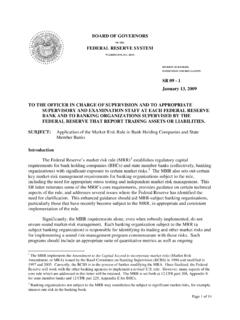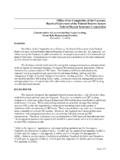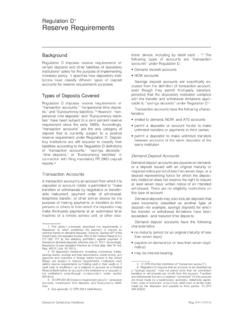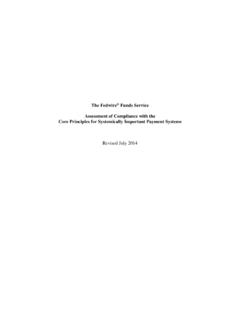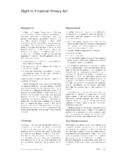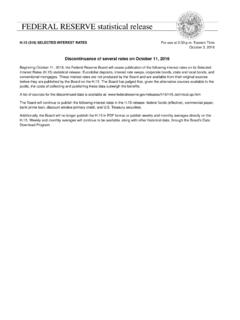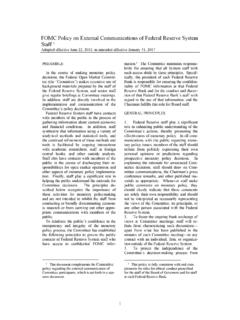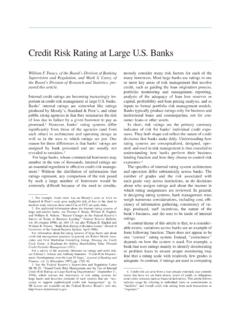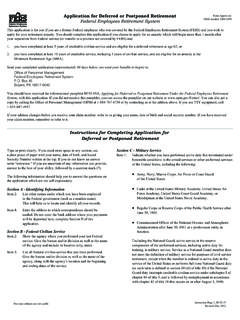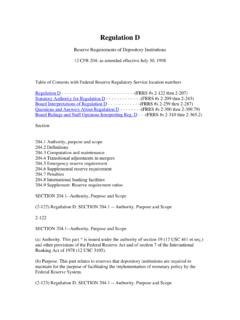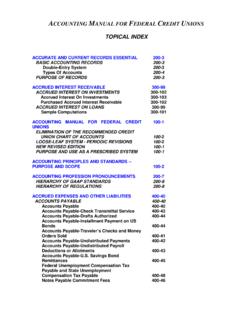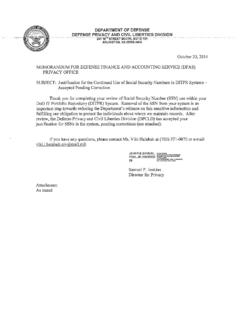Transcription of Guide to the Federal Reserve's Payment System …
1 Guide to the Federal Reserve's Payment System Risk Policy on Intraday Credit Effective July 12, 2012. Federal reserve System July 2012. This publication is available at i Table of Contents 1. I. Introduction .. 2. A. Policy History ..2. B. Overview of the PSR Policy ..5. II. Daylight Overdraft Capacity .. 8. A. Net Debit Caps ..8. B. Cap 1. 9. 2. 10. 3. De minimis .. 10. 4. Self-assessed .. 11. C. Maximum Daylight Overdraft 11. 1. General 12. 2. Streamlined procedure for certain foreign banking organizations (FBOs) .. 12. 3. Determination of the max cap amount under general and streamlined procedures .. 13. 4. Collateral pledged for max cap 13. 5. Examples of Maximum Daylight Overdraft Capacity .. 14. D. Role of an Institution's Board of E. Cap Resolutions ..16. F. Confidentiality of Cap Information ..18. III. Collateral .. 19. A. Collateral B. Collateral Valuation ..20. 1. Securities valuation .. 20. 2. Loan valuation .. 20. 3. Collateral 21. C. Pledging 1.
2 Fedwire Securities Service (FSS) .. 22. 2. Depository Trust Company (DTC) .. 22. 3. Third-Party Custody Pledging Arrangement .. 23. 4. Borrower-in-Custody of Collateral (BIC) Arrangement .. 23. 5. Foreign Depositories .. 24. 6. reserve Bank Custody .. 24. 7. In-transit Securities .. 24. D. Withdrawing Collateral ..25. 1. Fedwire Securities Service (FSS) .. 25. 2. Depository Trust Company (DTC) .. 25. 3. Custodians, BIC Arrangements, and reserve Bank Custody .. 25. 4. Foreign Depositories .. 26. E. Collateralized Daylight Overdrafts ..26. 1. Eligibility for zero-priced collateralized daylight 26. 2. Collateral available for daylight overdraft purposes .. 27. F. reserve Bank PSR Collateral Requirements ..27. ii _____. G. Collateral Monitoring ..28. 1. Intraday 28. 2. Ex post monitoring .. 29. IV. Daylight Overdraft Monitoring and 30. A. Daylight Overdraft Measurement ..30. B. Monitoring Compliance with the PSR Policy ..31. 1. Consequences of policy 32. C. Real-time Monitoring and the Account Balance Monitoring System (ABMS).
3 32. D. Ex Post Monitoring ..34. V. Daylight Overdraft Fees .. 35. A. Calculation of Daylight Overdraft Charges ..35. B. Example of Daylight Overdraft Charge Calculation ..35. 1. Calculation of end-of-minute uncollateralized daylight overdraft .. 36. 2. Calculation of daily daylight overdraft charge .. 36. 3. Calculation of reserve maintenance period charge and application of fee 36. C. Billing and Adjustments ..38. 1. Assessment of charges .. 38. D. Institutions Subject to Daylight Overdraft Penalty Fees ..39. VI. Special Situations .. 40. A. Branches and Agencies of Foreign Banking Organizations ..40. 1. capital equivalency .. 40. 2. Allocation of caps .. 41. B. Industrial Banks and Industrial Loan Companies Subject to the BHCA Exception .43. C. Institutions Subject to Daylight Overdraft Penalty Fees ..44. 1. Edge Act and agreement corporations .. 44. 2. Bankers' banks .. 44. 3. Limited-purpose trust companies .. 45. 4. Government-sponsored enterprises (GSEs) and international organizations.
4 45. VII. Self-Assessment Procedures .. 46. A. Creditworthiness Component ..46. B. Intraday Funds Management and Control ..51. C. Customer Credit Policies and D. Operating Controls and Contingency Procedures ..57. E. Overall Self-Assessment Rating ..60. Appendix A: Self-Assessment Worksheets .. 61. Appendix B: Sample Letters and Resolutions .. 93. Appendix C: Capital 101. Glossary .. 103. Preface 1. _____. Preface The Guide to the Federal Reserve's Payment System Risk Policy on Intraday Credit was developed to assist depository institutions in complying with the Federal reserve Policy on Payment System Risk (PSR policy). 1 The Board adopted the PSR policy to address the risks that Payment and settlement activity present to the financial System and to the Federal reserve Banks ( reserve Banks). The Guide contains detailed information on the steps necessary for depository institutions to comply with the Federal Reserve's policies on intraday credit (part II of the PSR policy).
5 Any institution using Federal reserve intraday credit, regardless of the amount, should monitor its Federal reserve account balance on an intraday basis and should understand the risks and costs inherent in the provision of Payment services generally. Users of the Guide should be aware that the information it contains is based on the PSR. policy effective at the time of publication. If the Board modifies the PSR policy, the revised policy will supersede information in the Guide until it can be updated accordingly. 1. Available at Introduction 2. _____. I. Introduction The Federal reserve Board (the Board) developed the PSR policy to address the risks that Payment systems present to the Federal reserve Banks, to the banking System , and to other sectors of the economy. The Board's intraday credit policy objective is to attain an efficient balance among the costs and risks associated with the provision of Federal reserve intraday credit, including the comprehensive costs and risks to the private sector of managing Federal reserve account balances, and the benefits of intraday liquidity.
6 An integral component of the PSR policy is a program to govern depository institutions'. use of intraday Federal reserve credit, or daylight overdrafts, which is the primary focus of this document. 2 A daylight overdraft occurs when an institution's Federal reserve account is in a negative position at any point during the business day. A. Policy History The Federal reserve first published a policy on risks in large-dollar Payment systems in 3. 1985. This policy required all institutions incurring daylight overdrafts in their Federal reserve accounts as a result of Fedwire funds transfers to establish a maximum limit, or net debit cap, on those overdrafts. 4. In subsequent years, the Federal reserve expanded the original PSR policy by addressing risk controls for other Payment types, including automated clearinghouse (ACH) transfers and book-entry securities transfers. 5 The PSR policy also has been expanded to address risk controls for other Payment systems, including large-dollar multilateral netting systems and certain private securities clearing and settlement systems.
7 6 In addition, the Federal reserve made several modifications to the original PSR program that include reductions to net debit cap levels, the creation of an exempt status for institutions that incur only minimal daylight overdrafts, and changes to the calculation of foreign banking organizations' (FBOs') capital equivalency. 7. In 1994, the Board began assessing a fee of 24 basis points for an institution's average daily overdrafts in excess of a deductible of 10 percent of the institution's risk-based capital. 8. The purpose of the fee was to induce behavior that would reduce risk and increase efficiency in the Payment System . At the same time, to facilitate the pricing of daylight overdrafts, the Board 2. In the PSR policy, the term institution refers to entities defined as depository institutions in 12 461(b)(1)(A), branches and agencies of foreign banking organizations, Edge Act and agreement corporations, bankers' banks that have not waived their exemption from reserve requirements, limited-purpose trust companies, government-sponsored enterprises, and international organizations, unless the context indicates a different reading.
8 3. 4. See 50 FR 21120, May 22, 1985. The Fedwire Funds Service is a large-dollar electronic Payment System owned and operated by the Federal reserve Banks. Fedwire is a registered service mark of the Federal reserve Banks. A complete list of marks owned by the Federal reserve Banks is available at 5. 6. See 52 FR 29255, August 6, 1987. 7. See 54 FR 26104, June 21, 1989. See 55 FR 22092, May 31, 1990. 8. See 57 FR 47084, October 14, 1992. Introduction 3. _____. modified its method of measuring daylight overdrafts to reflect better the timing of transactions affecting an institution's intraday Federal reserve account balance. 9 This measurement method incorporates specific account posting times for different types of transactions. In 1995, the Board raised the daylight overdraft fee to 36 basis points. 10 Because aggregate daylight overdrafts fell approximately 40 percent after the initial introduction of fees, the Board did not raise the fee further as was initially contemplated because it was concerned that further increases could produce market effects contrary to the objectives of the risk-control program.
9 The Board believed, however, that an increase in the overdraft fee was needed to provide additional incentives for institutions to reduce overdrafts related to funds transfers. The Board stated it would evaluate further fee increases two years after it could assess the effects of the 1995 fee increase. In 2000, recognizing its obligation to review fees and to consider changes that had occurred in the banking, Payment , and regulatory environment, the Board conducted a broad review of the Federal Reserve's intraday credit policies. The Board determined that these policies appeared to be generally effective in controlling risk to the Federal reserve and in creating incentives for institutions to manage their intraday credit exposures. While the Board found that the policy was generally effective, it identified growing liquidity pressures among certain Payment System participants. Specifically, the Board learned that a small number of financially healthy institutions regularly found their net debit caps to be constraining, causing them to delay sending payments and, in some cases, to turn away business.
10 The Board's broad review of its intraday credit policies culminated in its 2001 approval of a policy that allows certain institutions to pledge collateral to their Administrative reserve Bank (ARB) to secure daylight overdraft capacity in excess of their net debit caps, subject to reserve Bank approval. 11 The net debit cap plus the additional capacity is referred to as the maximum daylight overdraft capacity or max cap. This policy also contained changes to the calculation of net debit caps for branches and agencies of FBOs to allow certain FBOs to access increased amounts of intraday credit. In 2004, the Board announced two policy revisions pertaining to government-sponsored enterprises (GSEs) and certain international organizations. 12 At that time, reserve Banks 9. Before the Board's modification of the daylight overdraft posting rules, Fedwire funds and securities transfers were posted to institutions' Federal reserve accounts as they were processed during the business day (as they still are today).

